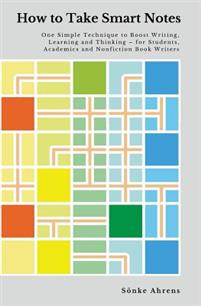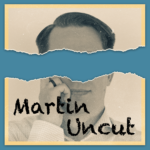How to Take Smart Notes by Sönke Ahrens is a book packed with information. The reason I found it was that I started to read up on how my new text editor, Obsidian, worked and how I best could structure my notes in this new world of note takers. The forums of Obsidian was the natural place to go to. There I found multiple suggestions and good ideas but the main theme of many of them was the use of something called Zettelkasten. Further research recommended Ahrens book with a promise to open the golden doors of knowledge organisation.
The purpose of the book is not to give you the knowledge of neither Zettelkasten or how to write smart notes. These are only tools to get you to the books ulterior motive; how to turn thoughts and discoveries into convincing written papers and build a treasure of smart and interconnected details together.

The book is structured into three sections. If your only goals is to learn how to work with Zettelkasten the first section, the introduction, would be enough to read. There you find the chapters with everything you need to know and things you need to keep in mind. That is quite literally the case, it is the name of the chapters. But the real treasure trove is in the chapters that follow. This is where you learn the underlaying principles and also get to learn, according to Ahrens, the six steps to successful writing.
Zettelkasten is a system to organise your knowledge and learnings into a system outside of your brain. A system you can trust and return to, even discussing your topics with. Nikolas Luhmann was a German clerk becoming a university professor and a very productive author of books and scientific articles over a wide range of topics. Luhmann credits his system and the workflow he used around it to his academic success. His system was in fact so efficient that it continued to produce books and articles even after Luhmanns passing. All based on manuscripts already startred but not finished by Luhmann. A testimony to the power of his system.
The system is simple but becomes extremely powerful over time. In the analog form you have two boxes. One for your reference notes. This can be, as an example, notes on articles or books read. These are only working notes and by themselves not any real bearer of knowledge or understanding. These are all processed and all your ideas and thought are extracted into short atomic notes. These notes are stored in the second box, your slip-box. Written with your own words. Being brief but with enough description that you can come back to the note at a later time and still understand the idea without having all the context. The note should also be linked to the reference material so that you can find your way back to that in the future if necessary. One other important step here is to link this new note to other notes in your slip-box that is in one way or another related to the new idea.
This can be done by asking questions. Questions like; How is this related to theses other cards I have in here? What does this mean for this other thing? Is this supporting or contradicting this information? Have I heard about this before? All these questions will help you to find relationships to information you already have and help you create the links. This does not only help you place the information but it also helps you learn and understand the new idea. You use your external system as a scaffolding for your new learnings. This is a powerful way to transform information into knowledge and understanding.
The majority of the book discusses why this actually works and how you can use it in your own writing. Arguing the writing of books and articles being the main reason for using a system like this. I think it cuts the usage short. It can be argued that you could use the same system and approach for any type of writing, with maybe the only limitation to prose or lyric. You could easily use a Zettelkasten as a power tool for blogs, podcasts, videos, movies, training programs, seminars, keynotes and of course fiction. I will probably never be able to write a book and my days in academia are all long gone. But I can use my system when I want to create a newsletter, blog post or a fact filled podcast episode. The pieces of lego can be used to construct a huge castle or a small car. The choice is up to the person in possession of the box with legos.
During my read I multiple times found similarities to the Getting Things Done methodology. One thing that struck me quite early on was the importance of getting things out of your head and into a trusted system. It is the Zettelkasten keeping track of my knowledge and my GTD system keeping track of my next actions. Both have the same goal giving me the space to use my head to come up with ideas not remember them.
Both systems also work with the notion of inboxes. A temporary storage area for notes and ideas that you should process. The last similarity I wanted to mention is the importance of separate categories. In Zettelkasten you differ between knowledge and reference material. In Getting Things Done it is the importance of separating actionable and non actionable materials.
Both Zettelkasten and GTD have been created though an empirical approach. Essentially; do like this because trial and error tells us this work. A big portion of Ahrens book talks about the science behind why these things work. There is a large and interesting list of reference literature. I have never in the past spent so much time investigating the references and found so much interesting reading as I done with this book.
How to Take Smart Notes by Sönke Ahrens is a well written book that explains the practical approach of Luhmanns Zettelkasten with the support of modern theoretical cognitive science and psychology. If your goal is to learn how Zettelkasten works, there are now a lot of other, more practical, material out there to be found. But if you want to learn how to build a large intertwined network of knowledge that you can use to create content and enjoyment for years; this is the book for you! I can highly recommend it!
If you prefer to listen instead you can listen to Martin Uncut, Ep 107 – Jun 4 – How to Take Smart Notes by Sönke Ahrens.





